Description
The National Instruments USRP-2901 is a versatile USRP Software-Defined Radio Device with a part number 784040-01, designed to cater to a wide range of applications in the wireless communication domain. Developed by the renowned National Instruments, this device is compatible with LabVIEW and the LabVIEW Communication System Design Module, providing a robust ADE for communication system developers. It offers flexible connectivity options through USB 2.0 and USB 3.0 interfaces, with an external power supply recommended when used with the USB 2.0 port.
With an instantaneous bandwidth of 56 MHz and supporting two channels, the USRP-2901 operates in a full-duplex mode, allowing simultaneous transmission and reception of signals. Its frequency tunability is enabled by the integrated tunable receivers, making it highly adaptable to various frequency bands. Incorporating Multiple-Input-Multiple-Output (MIMO) wireless technology, it is ideal for advanced communication systems that require high efficiency and spatial multiplexing.
The device’s RF frequency range spans from 70 MHz to 6 GHz, providing extensive coverage for different communication standards and applications, including white space utilization, sensor networks, broadcast FM, and operation in low-power unlicensed device bands. It is also suitable for use in land-mobile, public safety, amateur radio, and GPS network environments. Lastly, the USRP-2901 boasts a 12-bit ADC resolution, ensuring high-fidelity signal conversion for precise and reliable data acquisition.
| Specification | Details |
|---|---|
| Product Name | National Instruments USRP-2901 USRP Software-Defined Radio Device |
| Part Number | 784040-01 |
| Manufacturer | National Instruments |
| Application Development Environment (ADE) | LabVIEW, LabVIEW Communication System Design Module |
| Connection Interface | USB 2.0, USB 3.0 |
| External Power Supply Recommendation | Recommended for USB 2.0 connection |
| Instantaneous Bandwidth | 56 MHz |
| Number of Channels | 2 |
| Operating Mode | Full-duplex |
| Frequency Tunability | Yes, tunable receivers |
| Wireless Technology | Multiple-Input-Multiple-Output (MIMO) |
| RF Frequency Range | 70 MHz to 6 GHz |
| Applications | White space, sensor networks, broadcast FM, low-power unlicensed device bands, land-mobile, public safety, amateur radio, GPS networks |
| ADC Resolution | 12-bits |
Q1: What advantages does the full-duplex mode of the National Instruments USRP-2901 offer for simultaneous signal transmission and reception in advanced communication systems?
A1: The full-duplex mode of the National Instruments USRP-2901 offers significant advantages for advanced communication systems by enabling simultaneous signal transmission and reception, which can increase the efficiency of the communication system and is essential for implementing sophisticated techniques such as Multiple-Input-Multiple-Output (MIMO) technology that requires concurrent handling of multiple signal streams for high efficiency and spatial multiplexing.
Q2: What features make the National Instruments USRP-2901 an ideal device for developers in the wireless communication field, especially in terms of connectivity, bandwidth, and frequency range?
A2: The National Instruments USRP-2901 Software-Defined Radio Device features an instantaneous bandwidth of 56 MHz, full-duplex capability, frequency tunability across a 70 MHz to 6 GHz range, MIMO technology, and a 12-bit ADC resolution, making it suitable for a variety of applications, including white space utilization, sensor networks, FM broadcasting, public safety, amateur radio, and GPS networks. Its compatibility with LabVIEW and the LabVIEW Communication System Design Module significantly enhances its
Q3: What are the key features and applications of the National Instruments USRP-2901 Software-Defined Radio Device, and how does its compatibility with LabVIEW enhance its functionality for communication system developers?
A3: The National Instruments USRP-2901, with its RF frequency range of 70 MHz to 6 GHz, MIMO technology, and full-duplex mode, is best suited for a variety of wireless communication applications and environments including white space utilization, sensor networks, broadcast FM, operation in low-power unlicensed device bands, land-mobile, public safety, amateur radio, and GPS networks.
Q4: What are the key features and applications of the National Instruments USRP-2901 Software-Defined Radio Device, including its compatibility with LabVIEW, connectivity options, frequency range, and support for MIMO technology?
A4: The National Instruments USRP-2901 is an ideal device for developers in the wireless communication field due to its compatibility with LabVIEW and the LabVIEW Communication System Design Module, flexible USB 2.0 and USB 3.0 connectivity options, a broad instantaneous bandwidth of 56 MHz for accommodating wide-ranging signal types, full-duplex capability for simultaneous transmission and reception, tunable receivers for adaptable frequency usage, and an extensive RF frequency range of 70 MHz to 6 GHz, which
Q5: What wireless communication applications and environments are the National Instruments USRP-2901’s RF frequency range and features such as MIMO technology and full-duplex mode best suited for?
A5: The National Instruments USRP-2901 Software-Defined Radio Device boasts key features such as compatibility with LabVIEW and the LabVIEW Communication System Design Module, flexible USB 2.0 and 3.0 connectivity, a broad RF frequency range of 70 MHz to 6 GHz, full-duplex capability with an instantaneous bandwidth of 56 MHz across two channels, and support for MIMO technology. Its applications span white space utilization, sensor networks, broadcast FM, unlicensed device bands,



